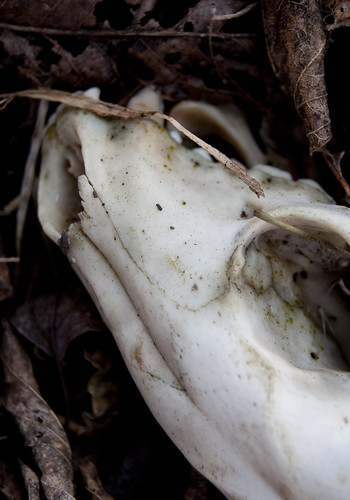On Monday afternoon, I was exploring more of the Matthaei Botanical Gardens' property, over near Mouse Marsh. I was on the lookout for deer, and I saw a few -- but only their white tails, as they were fleeing from me. At one point, a buck started to snort, but I never caught sight of him. Toward the end of my walk, I approached a sheltered area, surrounded by short trees, and I saw a raccoon skull resting atop the leaf litter. Nearby, peeking through the fallen leaves, were the two halves of its pelvis. The natural whiteness of the skull was beautiful against the earthy brown tones, making for a wonderful scene:

I sifted through the leaves and soil, and found the jaws of the animal, along with some of the front leg bones (a humerus as well as a pair of tibiae and fibulae), a scapula, a couple dozen phalanges, a few ribs, some vertebrae, and a baculum - meaning the raccoon was a male.
It's interesting to note that most of the ribs I found were damaged (broken), as was the very back of the skull, where the cranium connects to the atlas vertebra. Whether this damage was the cause of the raccoon's death (predation) or whether it was inflicted after the fact (scavenging) will probably never be known. As I mentioned earlier, the skeleton was found in a rather sheltered spot, making it both a more comfortable place for the raccoon to hide before dying, or a protected area for a predator to eat in peace. However, that is all speculation!
How long had the skeleton been there? The bones were all very clean, with not a scrap of ligament remaining, and were all relatively bleached, even the ones found beneath the leaves. However, there were no rodent gnaw-marks to be seen, which is interesting. Perhaps the raccoon died in the spring, and the hot summer months allowed for fast decomposition.
I'm finding I enjoy photographing skeletons just as much, if not more, than photographing recently-dead animals. Though bones are harder to relate to and perhaps not as "beautiful", they are far more intricate and provide for very interesting compositions. I also love to photograph these skulls and skeletons exactly as I find them: their immediate surroundings show just how much nature grows around these dead animals, and is nourished by them.
It's interesting to note that most of the ribs I found were damaged (broken), as was the very back of the skull, where the cranium connects to the atlas vertebra. Whether this damage was the cause of the raccoon's death (predation) or whether it was inflicted after the fact (scavenging) will probably never be known. As I mentioned earlier, the skeleton was found in a rather sheltered spot, making it both a more comfortable place for the raccoon to hide before dying, or a protected area for a predator to eat in peace. However, that is all speculation!
How long had the skeleton been there? The bones were all very clean, with not a scrap of ligament remaining, and were all relatively bleached, even the ones found beneath the leaves. However, there were no rodent gnaw-marks to be seen, which is interesting. Perhaps the raccoon died in the spring, and the hot summer months allowed for fast decomposition.
I'm finding I enjoy photographing skeletons just as much, if not more, than photographing recently-dead animals. Though bones are harder to relate to and perhaps not as "beautiful", they are far more intricate and provide for very interesting compositions. I also love to photograph these skulls and skeletons exactly as I find them: their immediate surroundings show just how much nature grows around these dead animals, and is nourished by them.




No comments:
Post a Comment